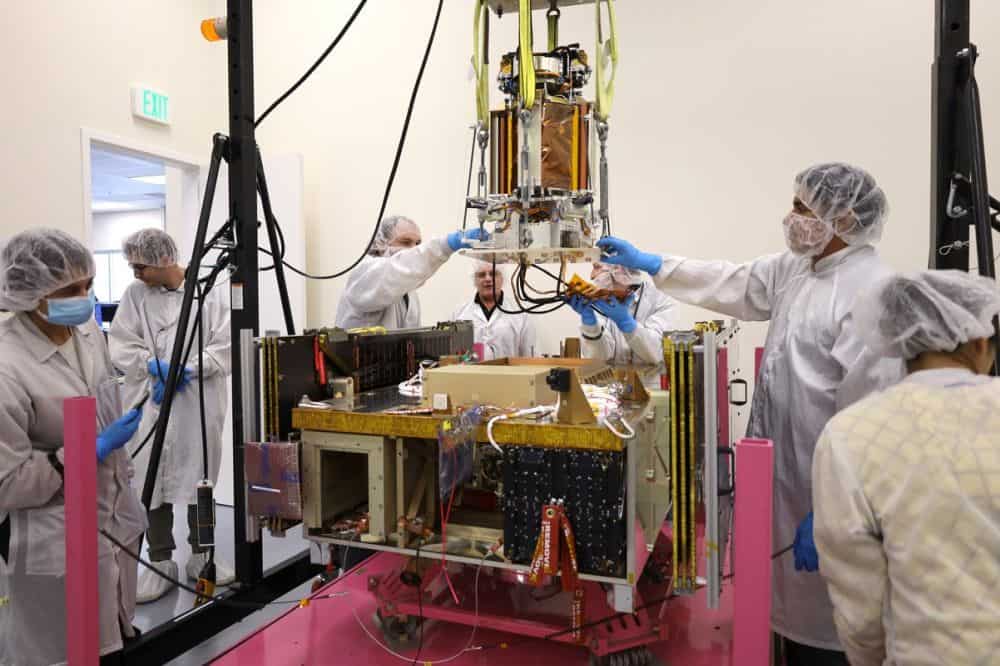
[Image above] Engineers carefully lower the DOLCE portion of the Space Solar Power Demonstrator onto the Momentus Vigoride spacecraft before the mission’s launch in January 2023. Credit: Caltech, Space Solar Power Project
Even as investment in clean energy technologies reaches new heights, the intermittent nature of solar and wind power remains a perennial challenge. The ability of atmospheric conditions to impede access to these energy sources means new storage technologies must be developed to store the energy when it is available.
What if there was a way to ensure predictable and constant access to these sources? Though the idea may sound like science fiction, space-based solar power systems could turn this possibility into reality.
Space-based solar power is the idea that high intensity, uninterrupted solar radiation could be collected in space using satellite-based solar panels. Because these panels would be outside Earth’s atmosphere, they would not be affected by clouds or nighttime. The collected energy could then be transmitted back to Earth in the form of lasers or microwaves.
The idea of harvesting solar energy in outer space and beaming it back to Earth traces its origins to a 1941 sci-fi short story. But scientific investigations in the succeeding decades demonstrated the real-world feasibility of this technique.
In June 2020, we reported on a project by the U.S. Air Force and U.S. Naval Research Laboratory to conduct the first orbital experiment with space-based solar power. The project, which had its results reported in a January 2021 paper, focused on the energy conversion process and resulting thermal performance of a 12-inch square panel dubbed the Photovoltaic Radio-frequency Antenna Module (PRAM).
The government researchers are now planning a follow-up experiment with aerospace company Northrop Grumman to send a panel of nine sandwich tiles into space, which this time will beam energy back to Earth. This experiment, which is planned to launch in 2025, will be in competition with a Japanese public–private partnership that aims to beam solar energy from space back to Earth in 2025 as well.
However, these initiatives will be competing for second rather than first place in the race to beam energy back to Earth, considering a recent announcement by the California Institute of Technology (Caltech).
On June 1, the university reported that a space solar power prototype designed by Caltech researchers, which launched into orbit in January 2023, demonstrated the ability to beam detectable power back to Earth for the first time.
The experiment is part of Caltech’s ongoing Space Solar Power Project (SSPP). SSPP owes its existence to the generosity of philanthropist Donald Bren, chairman of Irvine Company and a lifetime member of the Caltech Board of Trustees.
Bren first learned about the potential for space-based solar power through a Popular Science magazine article. In 2011, he approached Caltech’s then-president Jean-Lou Chameau to discuss the creation of a space-based solar power research project. In 2013, Bren and his wife, Brigitte, also a Caltech trustee, made the first of their donations—which now exceed $100 million—through the Donald Bren Foundation to fund the project.
The project also received financial support from Northrop Grumman, which provided Caltech $12.5 million between 2014–2017 through a sponsored research agreement.

From left: Sergio Pellegrino, co-director of the SSPP; Brigitte Bren; Donald Bren; Ali Hajimiri, co-director of the SSPP; and Richard Madonna, project manager of the SSPP. Credit: Caltech
The recent milestone experiment was achieved during testing of three key technologies on Caltech’s ongoing Space Solar Power Demonstrator (SSPD) mission.
- MAPLE (Microwave Array for Power-transfer Low-orbit Experiment). This array of flexible lightweight microwave power transmitters is the device that successfully beamed energy back to Earth. It uses constructive and destructive interference between individual transmitters to shift the focus and direction of the energy it beams out—without any moving parts.
- DOLCE (Deployable on-Orbit ultraLight Composite Experiment). A structure measuring 6 feet by 6 feet that demonstrates the architecture, packaging scheme, and deployment mechanisms of the modular spacecraft, which would eventually make up a kilometer-scale constellation forming a power station.
- Alba. A collection of 32 different types of photovoltaic cells to enable an assessment of the types of cells that are the most effective in the punishing environment of space.

The prototype antenna sheet for the MAPLE power transmitter array that demonstrates the unit’s flexibility. Each orange square on the yellow tile is an antenna to be driven by a single transmitter. Credit: Lance Hayashida, Caltech
An additional fourth component of SSPD is a box of electronics that interfaces with the Momentus Vigoride spacecraft computer and controls the three experiments.

Credit: Caltech, YouTube
According to the Caltech press release on this mission, the Alba tests of solar cells are ongoing; the team has not yet attempted to deploy DOLCE. Results from these experiments are expected in the coming months.
“The hard work and dedication of the brilliant scientists at Caltech have advanced our dream of providing the world with abundant, reliable, and affordable power for the benefit of all humankind,” Bren says in the press release.
Author
Lisa McDonald
CTT Categories
- Aeronautics & Space
- Energy
Related Posts
‘Fairy circles’ may help mark natural underground hydrogen deposits
September 18, 2025


